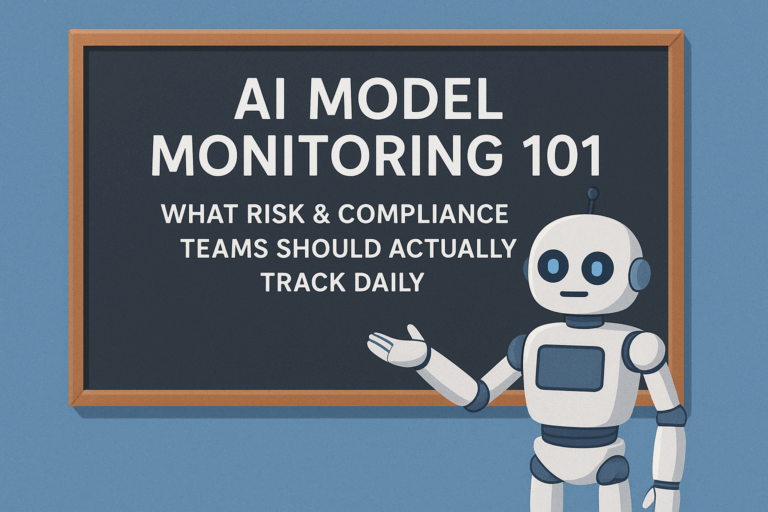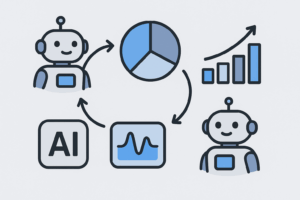Artificial Intelligence (AI) is no longer a pilot project—it’s running core business functions across finance, healthcare, retail, and government. But here’s the catch: AI doesn’t stay the same once deployed.
Models drift. Data shifts. Bias creeps in. And if you’re only running quarterly reviews, you’re already too late.
That’s why AI model monitoring isn’t a nice-to-have—it’s the frontline defense for risk and compliance teams. Yet many organizations don’t know what to actually track daily. Let’s fix that.
Why AI Model Monitoring Matters
Traditional governance often relies on periodic check-ins—audit once a quarter, review once a year. That approach doesn’t work for AI.
Models evolve with new data.
Decisions scale instantly across thousands (or millions) of people.
Small blind spots quickly become systemic failures.
As I argued in Beyond Checklists: Building a Proactive AI Risk Management Culture, governance that only looks good on paper will eventually collapse. Monitoring keeps governance alive, actionable, and responsive.
The 5 Metrics Every Risk & Compliance Team Should Track
1. Data Drift 📉
👉 Are the inputs feeding your model changing over time?
If your training data looks nothing like today’s real-world data, accuracy nosedives.
Case Example: During the pandemic, many retail demand forecasting AIs failed because shopping patterns (toilet paper hoarding, anyone?) looked nothing like the training set.
📍 Tie-back: As we covered in AI Risk Registers: What to Track, Measure, and Escalate in 2025, drift is one of the most critical risks to log and escalate early.
2. Bias Trends ⚖️
👉 Are model outcomes skewed toward or against specific groups?
Bias isn’t static. It can worsen over time as new data introduces hidden imbalances.
Case Example: Amazon scrapped its AI hiring tool after it learned to penalize resumes with the word “women’s” in them (Reuters). Even after fixes, ongoing monitoring would have been essential to prevent recurrence.
3. Override Rates 🚨
👉 How often are humans overriding AI recommendations?
If front-line staff repeatedly ignore model outputs, it’s a signal of mistrust or misalignment.
Case Example: In banking, loan officers often override automated lending decisions when they sense the model “doesn’t fit reality.” High override rates should trigger a review, not get buried.
4. Escalation Lag Time ⏱️
👉 How fast do risks flagged by monitoring actually move through your governance pipeline?
If it takes weeks for an anomaly to reach the right risk officer, your monitoring is a dashboard—not a safeguard.
📍 Tie-back: In The Human Oversight Layer: Why AI Governance Needs More Than Just Automation, I explained why escalation must be a cultural reflex, not a checkbox. Monitoring makes that reflex measurable.
5. Regulatory Alignment 🔍
👉 Does your monitoring align with evolving regulations (EU AI Act, U.S. AI EO, sector-specific rules)?
You can’t monitor everything, but you can map your metrics directly to compliance requirements.
Case Example: Financial institutions already follow SR 11-7 for model risk management. AI monitoring should extend the same rigor to drift, bias, and explainability.
Use Case: Healthcare AI in Diagnostics
Healthcare offers a sharp reminder of why monitoring matters. A 2019 study found that a widely used diagnostic AI systematically underestimated care needs for Black patients due to biased training data (Science).
Without monitoring bias trends in real time, patients suffered unequal care. This isn’t just a compliance miss—it’s a human impact failure.
How to Make Monitoring Stick (Beyond the Dashboard)
Monitoring only works if it’s tied to actionable workflows:
Alerts should trigger clear escalation playbooks.
Metrics should be reviewed weekly in governance forums, not quarterly audits.
Findings should be logged in the AI risk register so they feed into broader risk strategy.
In other words: monitoring isn’t an IT task—it’s a cross-functional governance muscle.
The Bottom Line
AI governance that ignores daily monitoring is just hope disguised as compliance.
If you’re in risk or compliance, don’t settle for quarterly reports. Ask your teams:
What metrics are we tracking every day?
Who owns the response when drift or bias is detected?
How fast can a flagged issue escalate to leadership?
Because in AI, the organizations that monitor daily won’t just be compliant—they’ll be resilient.
✅ Want more? Explore how culture and oversight shape strong AI governance in:




